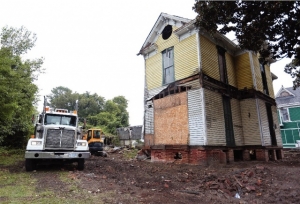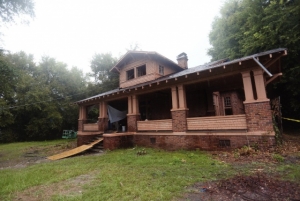Slated to be saved
By Ethan Smith
Published in News on August 31, 2015 1:46 PM

News-Argus/CASEY MOZINGO
A crew clears debris from around the Best-Mangum house on the 300 block of John Street. The house, which was scheduled to be demolished, has been recently acquired by Preservation North Carolina, which plans to restore the home, which was built in the 1890s.

The Paul Borden House
Thanks to a $200,000 anonymous donation, a $30,000 gift from the Hillsdale Fund of Greensboro and the ongoing efforts of Preservation North Carolina, two historic houses in downtown Goldsboro will be getting facelifts to get them ready for sale.
The Best-Mangum House at 302 S. John St., and the Paul Borden House at 305 W. Mulberry St., have both been pulled from the city of Goldsboro's accelerated demolition list and renovations on them have begun.
At the Best-Mangum House, the porch has already been stripped away revealing that it was originally much smaller when the house was first built in the 1890s.
"These two houses are among the finest left in downtown Goldsboro," said Robert Parrott, regional director for PNC. "The Paul Borden House, a fine brick craftsman bungalow, was badly damaged by fire and left open to the elements for some time. The M.J. Best House, an important Victorian structure built by a prominent business leader, was the victim of an unsympathetic owner who PNC finally had to take to court. Both houses were scheduled for demolition in June, and PNC was able to get both houses donated to us, subject to liens."
Parrott said the organization stepped in to save the Best-Mangum House after he received a letter notifying him that the house had been condemned and placed on the list for demolition.
It was not initially PNC's intention to include the Paul Borden House in its efforts to renovate properties in Goldsboro, but it became an opportunity officials couldn't pass up after seeing it.
The organization did not step in until the property had been condemned by the city.
"We went by it, and we thought, 'We gotta save this thing,'" Parrott said. "It's unique to the downtown area, you know, because there's not very many brick houses in that area."
Both Parrott and PNC's office and properties manager Dawn Williams said it is unusual for PNC to directly intervene with property renovations. Usually, the organization only deals in acquiring and selling properties.
"We don't typically take on projects like this, but we want to be a catalyst that spurs other people to action," Ms. Williams said. "There have already been great efforts made to save historic homes in Goldsboro by a lot of people, and we want to help along those existing efforts."
Preservation North Carolina chose the two properties because they are considered "anchor properties" -- key properties in a neighborhood that are considered a centerpiece, or a property crucial to the growth of a community.
The organization is looking for an additional $100,000 to substantiate the existing donations and provide enough funds to complete all the necessary renovations.
"I hate to say it, but we won't be able to finish these projects with any money left," PNC president Myrick Howard said. "The needed repairs are pretty substantial. But these projects are about more than just these two houses. It's about helping the neighborhoods they're in."
Parrott said finding anchor properties in any neighborhood can be of the utmost importance to the success of a neighborhood's revitalization.
"We are taking on these two houses not only to save them, but also to help anchor our neighborhood revitalization efforts," Parrott said. "Sited on a large lot, the Paul Borden House is one of the most substantial houses east of downtown Goldsboro. Its loss would be a huge setback to our ongoing efforts in the Walnut-Mulberry-Virginia Street neighborhood. We plan to rebuild its roof (by) re-laying the slate on the front and address the considerable structural damage resulting from the fire and subsequent water intrusion. We will have to replace numerous walls and floors in order to mitigate possible mold problems. We hope to be able to at least install the new interior walls and floors with funds that are currently available. With more funds, we can work on reinstalling the trim and roughing in mechanical systems. We aim to get the house to a point where buyers can feel confident that they can finish the job in a timely way and on budget.
"At the M.J. Best House, PNC plans to construct an addition that will bring the house back to its original size and provide space for bathrooms, closets and kitchens. The entire foundation will have to be rebuilt, due to 130 years of deterioration and subsequent 'jackleg' repairs. Recent demolition of the later additions confirmed our belief that the house's original porches were much smaller. We will work to rebuild the porches to their original appearance."
Howard said the company is not yet sure exactly how much money will be necessary to complete the renovations.
A structural engineer visited the site earlier this month and PNC is waiting on the report to see how much specific repairs will cost.
"It's a case where you have to break the egg before you can make the omelet," Howard said. "We will be flying blind on some of the costs of the repairs because we aren't sure what the extent of the damage to the two properties is until we are able to look at that report."
The ultimate goal, Parrott and Howard said, is to create a marketable product that will be easy to renovate when purchased by new owners.
"We hope that these two houses will increase the market values of their surrounding houses by providing the higher comps that are critical to the stability of this neighborhood," Parrott said. "Only after market values in the neighborhood have increased will we ever see compatible market-rate new construction on the many vacant lots in the area. Our ultimate goal will be reached when we see compatible new houses, condos or apartments being built on the vacant land in the area. That revival is critical for the city. As our president, Myrick Howard, has pointed out, 'A city's downtown is like its living room: It makes a tremendous impression, positive or negative, on prospective employers, investors, and residents.'"
